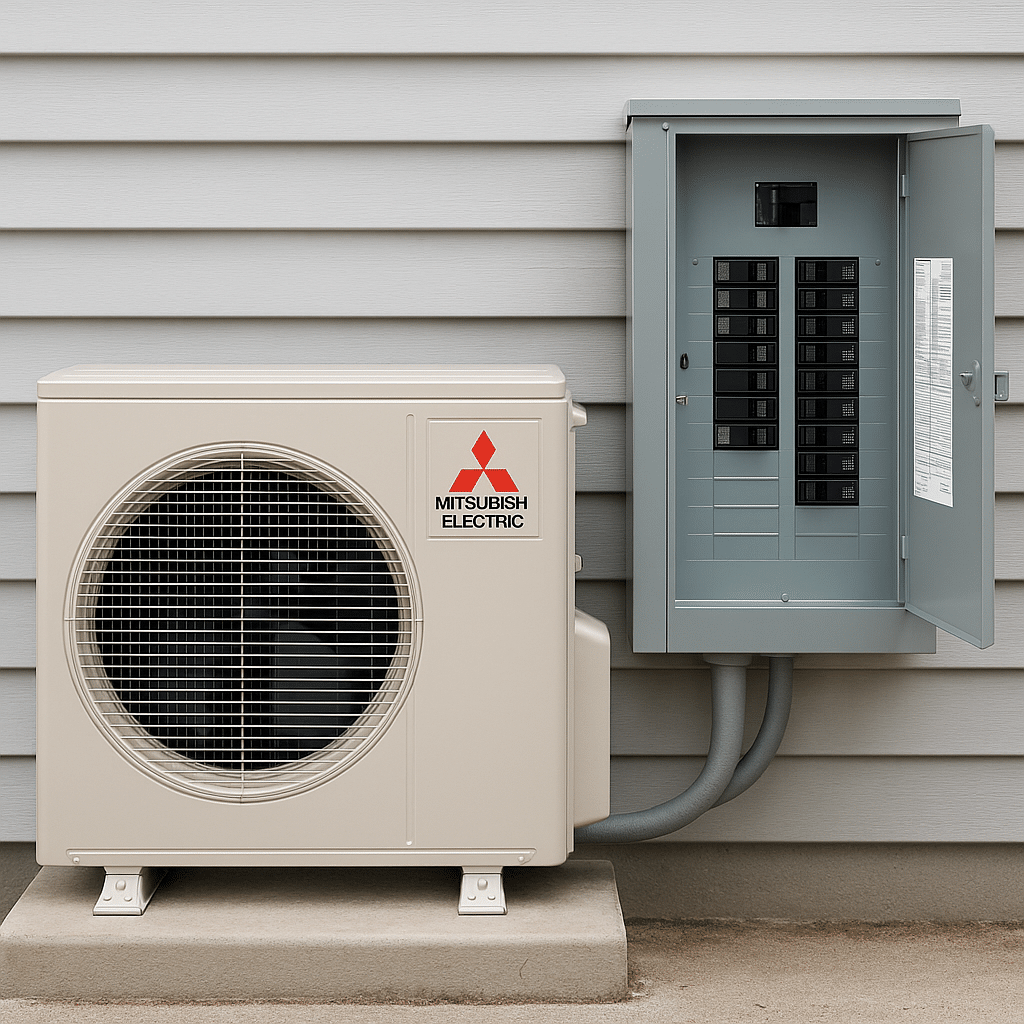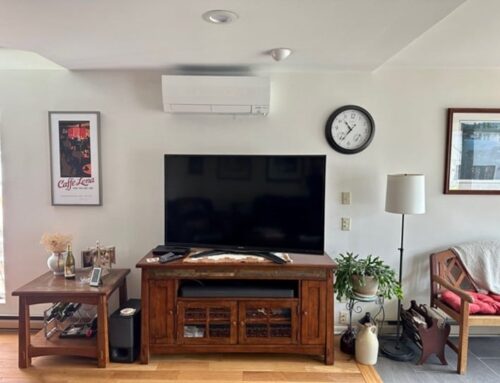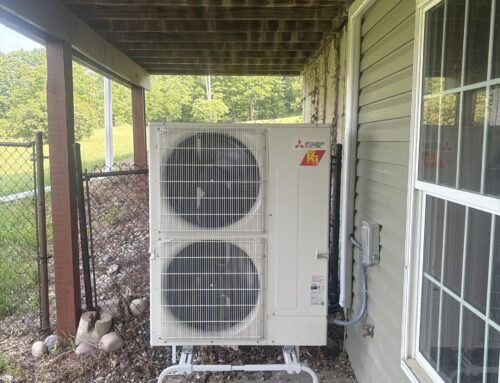
Overview
If you're reading this, you're probably wondering whether the electrical panel in your Upstate New York home can handle a new heat pump. Switching to an air‑source or ground‑source heat pump is one of the best ways to reduce carbon emissions and lock in year‑round comfort, but doing it right requires looking beyond the equipment itself. The electrical panel—the metal box that houses the breakers in your basement, garage or utility closet—is the gateway through which every kilowatt flows. If that gate is too small or too old, it can stop your project in its tracks.
This article goes deep on the topic. It explains how to determine your panel's capacity, why some homes need a 200‑amp service upgrade, what the National Electrical Code (NEC) and local inspectors require, and how to avoid unnecessary upgrades. We'll also cover typical upgrade costs, rebates and tax credits available through NYSERDA, utilities and the IRS, and smart strategies that let you run a modern, electrified home on existing 100‑amp infrastructure.
Our goal is to arm you with practical information so you can make an informed decision, avoid surprises and convert curiosity into action. Throughout the article you'll find local examples from Albany, Saratoga, Ticonderoga and other Upstate communities, as well as expert advice from licensed electricians and building science professionals.
Quick Answer: Most single‑zone Mitsubishi heat pumps will run fine on a 100‑amp panel as long as they are given a dedicated 240‑volt circuit. Whole‑home systems with multiple indoor units, high electrical loads (like EV chargers or induction stoves) or older panels nearing the end of their life often require a 200‑amp upgrade or smart load management. Always have a professional load calculation performed before making a final decision.
Electrical Panel Basics and Why Capacity Matters
What an Electrical Panel Does
Your panel (often called a breaker box, load center or fuse box) is the central hub that takes incoming power from your utility's service drop and distributes it to individual circuits throughout your home. Each circuit is protected by a circuit breaker designed to trip if the current exceeds safe levels. The panel's main breaker governs the maximum amperage your entire house can draw at any moment. Panels are sized by this number—60, 100, 150, 200 amps, etc.—and that size sets the upper limit on how many large appliances you can run simultaneously.
How to Determine Your Panel Size and Condition
To figure out whether your existing panel can handle a heat pump:
-
Locate the panel – It's usually near where the power enters your home, such as in a basement, utility closet or garage. Some homes have subpanels feeding a remote area or addition.
-
Check the main breaker – The amperage rating is often printed on the large switch at the top. If not, look for a label or stamping inside the panel door. Many older panels have 60‑ or 100‑amp main breakers, while newer homes built after the 1990s often have 150‑ or 200‑amp breakers.
-
Inspect breaker slots – Count the number of spaces and look for open slots. A 100‑amp panel typically has 20–30 spaces; a 200‑amp panel may have 40–60. More spaces mean more circuits can be added without doubling up.
-
Consider age and wear – Panels last roughly 25–40 years. If your panel is from the 1970s or early 1980s, it could have outdated technology (e.g., Zinsco or Federal Pacific brands) and may no longer meet safety codes. Flickering lights and frequent breaker trips are signs of overloaded or failing equipment.
-
Hire a licensed electrician – For older panels or uncertain amp ratings, a professional can measure the service entrance conductors, verify the main breaker capacity and check for code compliance.
Why Panel Capacity Matters for Heat Pumps
Heat pumps use electrical energy to extract heat from outdoor air (or the ground) and deliver it indoors. Even high‑efficiency models draw significant power when operating at full capacity. A typical single‑zone Mitsubishi mini‑split needs a 15–30 amp, 240‑volt circuit depending on the size, while multi‑zone systems can require 40–60 amps or more when all heads run simultaneously. When you add additional appliances—an electric dryer, induction cooktop, EV charger, well pump or hot tub—the cumulative load can exceed what a 100‑amp panel can safely deliver. Exceeding panel capacity causes breakers to trip, wires to overheat and risks failing inspection.
NYSERDA notes that households looking to install heat pumps for space or water heating may need a 200‑amp service upgrade if their existing panel is less than 200 amps. The latest Energy Efficient Home Improvement Credit (25C) from the IRS specifically requires panels and related electrical components to have a capacity of 200 amps or more to qualify for the $600 credit. These requirements illustrate why panel capacity and code compliance have become central issues in electrification projects.
Understanding 100‑Amp vs 200‑Amp Panels
Comparing Features, Capacity and Use Cases
| Feature | 100‑Amp Panel | 200‑Amp Panel |
|---|---|---|
| Typical breaker spaces | 20–30 | 40–60+ |
| Max continuous load | ~19,200 watts | ~38,400 watts |
| Suitable for | Small to medium homes; single‑zone heat pumps; limited electric appliances | Larger homes; multi‑zone heat pump systems; multiple EV chargers and electric appliances |
| Common upgrade triggers | Panel full, load calculation >80% capacity; adding high‑draw equipment | Future‑proofing whole‑home electrification; installing multiple heat pumps, EV chargers or battery systems |
| Upgrade cost range | Often replaced entirely instead of upgrading | $2,500–$4,500 for a full panel upgrade |
When a 100‑Amp Panel Is Sufficient
Many homes in Upstate NY still have 100‑amp service. If your total household electrical load stays below roughly 80 amps (80% of the panel's rating) and you dedicate a 15–30 amp circuit for your new heat pump, you may not need to upgrade. Factors that make a 100‑amp panel viable include:
-
A single‑zone or small multi‑zone heat pump
-
Gas or propane water heater, stove and dryer
-
No electric vehicle or a low‑power Level 1 charger (120‑volt)
-
No plans to add large electric loads in the next decade
Signs You Need a 200‑Amp Panel
You should consider a service upgrade if:
-
Multiple high‑draw appliances are present or planned (EV charger, electric range, electric water heater, hot tub, etc.).
-
You want whole‑home heating and cooling with multiple indoor units, which may require 40–60 amps for the heat pump system alone.
-
Your breaker panel is full or nearly full, leaving no room for new circuits.
-
The load calculation exceeds 80% of the panel's rated capacity. A professional electrician uses a formula from the National Electrical Code (NEC) to add up the amps required by all fixed appliances, general lighting (3 watts per square foot), small appliance circuits and the largest motor load. If the sum exceeds 80% of your main breaker rating, a larger panel or load management is recommended.
-
The panel is approaching the end of its life (25–40 years old) or has outdated safety features.
Homeowners thinking long‑term should realize that a 200‑amp panel is often sufficient to power an all‑electric home. With New York's climate goals pushing for widespread electrification, upgrading now can prevent headaches later.
Electrical Panel Upgrade Costs in Upstate NY
Prices vary based on panel size, service entrance wiring, permitting and local labor rates. The following figures provide a realistic range for Upstate New York.
Subpanel Installation ($800–$1,500)
A subpanel is a smaller breaker box fed from your main panel. It doesn't increase your overall service capacity but adds breaker slots. Subpanels are ideal when your existing 100‑amp panel still has headroom but lacks physical spaces. Expect costs around $800–$1,500 for installation, including materials and labor.
Full 200‑Amp Panel Upgrade ($2,500–$4,500)
Upgrading to a 200‑amp panel involves replacing your existing panel with a larger one, upgrading the service entrance cable, possibly replacing the meter socket and coordinating with your utility company. Costs typically range between $2,500 and $4,500 in Upstate NY. Factors affecting price include:
-
Distance from the meter to the panel – Longer runs require more conductor and labor.
-
Wiring complexity – Conduit runs through finished spaces or masonry walls increase costs.
-
Condition of service entrance and grounding – If the existing service wire is degraded or undersized, you may need to upgrade it at additional expense.
-
Permit requirements – Local code offices and utilities charge fees for inspections and meter pulls. Rural areas may have lower costs than cities.
-
Utility coordination – The utility must disconnect and reconnect the service; scheduling can add time.
Smart Panels and Load Management Devices
Instead of or in addition to upgrading service, homeowners can install smart panels or load management devices. Smart panels (e.g., Span, Leviton Smart Load Center) are internet‑connected breaker boxes that monitor and control circuits to keep total load below your main breaker rating. A load management device can automatically shed or pause lower priority loads (like an EV charger) when a high‑priority load (like a heat pump) turns on. NYSERDA notes that smart panels can enable fully electrified homes without upgrading the service by optimizing load profiles.
Smart panels cost $3,000–$5,000 installed, similar to a full 200‑amp upgrade, but they provide long‑term flexibility and detailed energy monitoring. Consult your electrician and utility to determine whether a smart panel is approved for interconnection in your area.
Avoiding Unnecessary Upgrades: Load Management Strategies
If your load calculation is close to the threshold, consider the following strategies to avoid a costly service upgrade:
-
Install a Load Management Device – Devices like the Eaton Energy Management System or demand controllers can shed loads to keep the main breaker from tripping. For example, a load controller might temporarily turn off your electric water heater or EV charger when the heat pump starts.
-
Stagger High‑Draw Loads – Time‑of‑use planning can prevent simultaneous operation. For instance, run your clothes dryer or oven when the heat pump is off. Smart thermostats and EV chargers often have scheduling features.
-
Choose Lower MCA Equipment – Some Mitsubishi and other brand units have lower Minimum Circuit Ampacity (MCA) requirements. A 9,000 BTU mini‑split might need only 15 amps, whereas a 36,000 BTU unit could require 30 amps. Discuss options with your HVAC contractor.
-
Reduce Other Loads – Upgrade to ENERGY STAR appliances, LED lighting, and high‑efficiency water heaters. These reduce your base load and may free up capacity for the heat pump. NYSERDA notes that adding appliances or EV chargers to a 100‑150 amp panel can exceed capacity, so efficient replacements help.
-
Use Subpanels Appropriately – A subpanel won't increase service capacity, but it can centralize circuits for an addition or garage. When combined with load management, it keeps your main panel organized and reduces double breakers.
The Permitting and Installation Process
Upgrading your electrical panel or installing a heat pump is not a DIY job; it involves licensed electricians, permits, inspections and, in some cases, utility coordination. Here's what to expect:
-
Consult an HVAC and Electrical Professional – A qualified heat pump contractor should partner with a licensed electrician to review your current panel, calculate your load and propose options.
-
Perform a Load Calculation – The electrician uses NEC Article 220 to calculate your dwelling's service load. They'll add up fixed appliances, lighting load (3 W per square foot), small appliance circuits, the largest motor load (e.g., heat pump compressor) and a demand factor. This determines whether your 100‑amp service is adequate.
-
Obtain a Permit – Upgrades require an electrical permit from your local building department. Fees range from $50 to $200 depending on location.
-
Schedule the Work and Utility Disconnect – Your electrician will coordinate with the utility to disconnect power on the day of the upgrade. The work usually takes 6–8 hours. Plan for a power outage.
-
Install and Inspect – The electrician will replace the panel, install new breakers and verify grounding and bonding. An inspector will check that everything meets NEC and local amendments. Only then will the utility reconnect service.
-
Document for Rebates and Tax Credits – Keep invoices and documentation from your electrician. For the federal Energy Efficient Home Improvement Credit, the new panel must be 200 amps or larger. To claim the credit, file IRS Form 5695 with your tax return.
Rebates, Tax Credits and Incentives for Electrical Upgrades
Federal 25C Credit (Energy Efficient Home Improvement Credit)
The 25C credit provides a 30% tax credit (not a deduction) on qualifying home energy improvements. For electrical upgrades:
-
Costs of panelboards, sub‑panelboards, branch circuits and feeders needed to support residential energy property qualify when they meet the National Electric Code and have a capacity of 200 amps or more.
-
The credit is capped at $600 per item.
-
The credit resets each year; there is no lifetime limit between 2023 and 2032.
-
To claim, file Form 5695 with your tax return for the year the panel is installed.
Heat pumps themselves qualify for a separate $2,000 annual credit under the same provision.
NYSERDA Programs and NY State Rebates
NYSERDA offers programs that can assist with electrical upgrades when they are part of a heat pump or energy efficiency project:
-
NYS Clean Heat Program – Provides rebates on air‑source and ground‑source heat pumps through participating utilities. Some rebates include incentives for associated electrical work. The exact rebate depends on your utility (National Grid, NYSEG, Central Hudson, RG&E, etc.) and system size.
-
Appliance Upgrade Program – Covers up to 100% of the cost of electrical panel and wiring upgrades for income‑eligible households installing heat pump appliances.
-
EmPower+ Program – Provides funding for electrical upgrades in conjunction with energy efficiency improvements.
-
Regional Programs – Counties and municipalities sometimes have additional grants or low‑interest financing for electrification projects. Check with your local energy council.
Utility Rebates
-
National Grid and NYSEG often bundle heat pump rebates with incentives for necessary electrical work. For example, National Grid's Clean Heat rebate may provide additional funds if a panel upgrade is needed for heat pump installation. These programs change annually—consult your utility's Clean Heat site for current offers.
-
Some utilities have pilot programs for smart panels or demand response devices. Participating can lower the cost of a smart panel install and provide ongoing bill credits for load shedding.
Other Financing Options
-
Low‑interest loans through the NYSERDA Green Jobs – Green New York program can finance panel upgrades and heat pumps together.
-
Federal rebates under the Inflation Reduction Act may be rolling out in 2025 and could provide up‑front discounts on electrical upgrades based on income.
Local Examples and Case Studies
Albany Ranch – Making 100 Amps Work
A single‑story ranch in Albany built in 1968 had a 100‑amp panel with 24 slots. The homeowner wanted a 9,000 BTU Mitsubishi hyper‑heat mini‑split for a bedroom. After a load calculation, the electrician found that the total load was only 55 amps, leaving 45 amps headroom. A single‑pole 15‑amp breaker and 12/2 gauge wire were run to the outdoor unit. No panel upgrade was required. With LED lighting, gas stove and dryer, and no EV charger, the panel handled the additional circuit easily. Total project cost: $4,800 for the heat pump and $350 for the dedicated circuit.
Saratoga Colonial – Upgrading to 200 Amps
A 1970s two‑story colonial near Saratoga Springs had a 100‑amp panel already maxed out with breakers for electric range, well pump, two 40‑gallon electric water heaters and baseboard heaters. The owner wanted a multi‑zone Mitsubishi heat pump with three indoor heads and a heat pump water heater. The load calculation exceeded 95 amps. The electrician recommended upgrading to a 200‑amp panel and replacing the aged service entrance cable. Total cost: $3,800 for the electrical upgrade (including meter and permit) and $13,500 for the heat pump system. The homeowner claimed a $600 panel credit and a $2,000 heat pump credit, lowering their tax liability by $2,600.
Ticonderoga Camp – Subpanel Solution
A seasonal camp on Lake George ran on a 100‑amp main panel but had space constraints for new circuits. The owner wanted to add a small 12,000 BTU mini‑split in the living room and an EV charger for their plug‑in hybrid. Instead of upgrading service, an electrician installed a 60‑amp subpanel in the garage for the EV charger and heat pump. A load management device prioritised the mini‑split during cold snaps, temporarily pausing the EV charger if necessary. The project cost $1,200 for the subpanel and management device. The homeowner still claimed the $600 25C panel credit because the subpanel supported energy property (the mini‑split) and met the 200‑amp capacity requirement on the feeder.
Frequently Asked Questions (FAQ)
Can a heat pump run on 100‑amp service?
Often yes. Many single‑zone systems draw 15–30 amps and work safely on a 100‑amp panel when connected to a dedicated 240‑volt circuit. The key is to perform a proper load calculation. If your total load stays below 80 amps and you have open breaker slots, you can avoid an upgrade.
Do I always need a 200‑amp panel for a heat pump?
No. It depends on your home's electrical load, not just the heat pump. Homes with gas appliances or minimal electrical loads may run a heat pump on 100 amps. However, modern electrified homes—with electric vehicles, induction cooktops, and multiple heat pumps—often need 200 amps or smart panel solutions.
Is a 200‑amp service required by code?
Neither the National Electrical Code nor New York State code mandates a 200‑amp service for heat pump installations. Instead, code requires that service capacity must not be exceeded. The 25C tax credit does require panels to be 200 amps or larger to claim the $600 credit.
How much does a panel upgrade cost in Upstate NY?
A full 200‑amp upgrade usually costs $2,500–$4,500. A subpanel installation runs $800–$1,500. Smart panels cost $3,000–$5,000 but may avoid an expensive utility service upgrade.
What rebates are available for panel upgrades?
You can claim a 25C federal tax credit worth 30% of the cost up to $600 per item. NYSERDA and utility programs may cover a portion of upgrade costs, especially for income‑eligible households. Always subtract rebates from your qualifying expenses when calculating the credit.
Do I need an electrician or can I upgrade the panel myself?
You must hire a licensed electrician. Panel upgrades involve working with high‑voltage lines and require permits and inspections. DIY work on service equipment can void your homeowner's insurance and pose serious safety hazards.
What is the difference between a panel upgrade and a service upgrade?
A panel upgrade replaces the breaker box while keeping the same service entrance capacity (e.g., replacing a 100‑amp panel with a newer 100‑amp panel). A service upgrade increases the amperage delivered by the utility (e.g., upgrading from 100 amps to 200 amps). Often both are done together because the original service wiring and meter may be sized for 100 amps. Smart panels offer a middle ground by managing loads without increasing service amperage.
Save More, Stay Informed!
Sign up for our newsletter and be the first to receive:
✅ Exclusive Sales & Rebates on Mitsubishi Heat Pumps.
✅ Industry News and Expert HVAC Tips.
✅ Updates That Help You Save Energy and Money.





